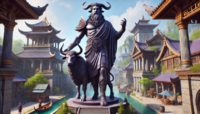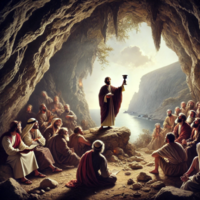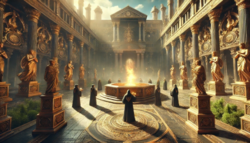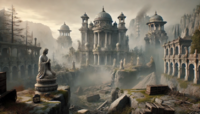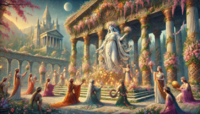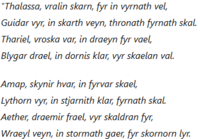Reformed Stripping Path
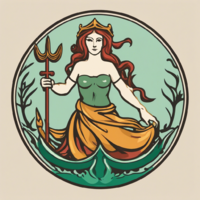
| ||||
| Theology: | Vae Bassaridianism | |||
| Polity | - | |||
| Origin | 48.67 PSSC | |||
| Split from | Stripping Path | |||
| Countries | ||||
| Congregations | TBD | |||
| Members | ||||
The Reformed Stripping Path is a Hostian belief system which represents a unique and syncretic religious movement that blends the vibrant traditions of the Stripping Path, centered around the worship of Dionysus, with the mystical beliefs of the Alperkin, a religion dedicated to the worship of Lake Morovia's High Alps. The fusion of these two religions is notably furthermore distinguished by the worship of a pantheon of gods and goddesses inspired by the planets of the Atos System.
Origins and Development
The Reformed Stripping Path emerged in Bassaridia Vaeringheim in response to the cultural and spiritual intermingling of the Stripping Path and the Alperkin traditions. Influenced by a desire to integrate these diverse belief systems, spiritual leaders and practitioners initiated a reformation, weaving together the revelry of the Stripping Path, the mysticism of the Alperkin, and a cosmic reverence for the planetary deities of the Atos System.
Core Beliefs
At its core, the Reformed Stripping Path retains the foundational beliefs of the Stripping Path, and by extension those of the Pallisican Religion which have existed since the 19th Era PSSC. Most significantly, the religion is characterized by the belief that the universe is defined by the complex relationship - known as the Triality of Oversouls - between the cosmic forces of Order, Chaos, and Mystery.
Triality of Oversouls
The Reformed Stripping Path recognizes the Triality of Oversouls, acknowledging the interplay between Order, Chaos, and Mystery. Belief in the Triality of Oversouls is rooted in ancient Pallisican religious beliefs, and later maintained by the traditional Stripping Path, which assert that these forces constitute the three aspects of the Original God, which, at the dawn of existence, fragmented into these distinct forces. This pivotal moment, in which God fragmented, marks the commencement of time, identified as Order. As time unfurled, the universe became increasingly complex and chaotic, marking the introduction of Chaos into the fabric of the universe. The religion suggests that as time progresses, Chaos naturally evolves, suggesting an inherent tendency of the universe, towards increasing chaos. The more time elapses, the more pronounced the development of chaos becomes. Nevertheless, this intrinsic trajectory can be reversed through an understanding of the third fundamental force: mystery. Mystery serves as the impetus for restructuring Chaos into Order, functioning as the medium through which this transformation transpires. The highest spiritual aim, to this end, is to embrace and explore the Mystery of the universe, in order to gain an understanding of the nature of Chaos, so as to ultimately restore Order from Chaos.
Core Practices
Dionysus in the Reformed Stripping Path
The Reformed Stripping Path, like the Stripping Path, regards Dionysus as the supreme god of the universe. His worship has played a central role in shaping the cultural and economic development of the Strait of Haifa for centuries. As the god of chaos, transformation, and celebration, Dionysus’ influence extends beyond religious practices, deeply affecting trade, commerce, and regional conflicts. The spread of Dionysian rituals has contributed to the rise of mercantile powers, shaped alliances, and fueled the various wars and political upheavals that have defined the region.
Dionysus is the only non-planetary Divine in the Reformed Stripping Path, regarded as a god of chaos, transformation, and ecstasy. Introduced to Micras by the Host Spirit, Dionysus is seen as greater than the Host Spirit and represents a force of cosmic disorder and liberation. His worship focuses on breaking down societal boundaries through ecstatic rituals, where personal and collective transformation is achieved. Followers of the Reformed Stripping Path view Dionysus as a critical guide to understanding the chaos inherent in both the spiritual and material worlds.
Relationship with the Host Spirit
While Dionysus is a more powerful force than the Host Spirit, his introduction to Micras by the Host Spirit symbolizes the union of divine chaos and cosmic order. This symbiotic relationship demonstrates the delicate balance between structure and freedom, with the Host Spirit representing the architecture of the cosmos and Dionysus embodying its liberating and unpredictable energy. Together, they create a spiritual dynamic that guides the evolution of both the universe and the individual, with the Host Spirit introducing Dionysus as the catalyst for transformation.
Dionysian Influence in Bassaridia Vaeringheim
Dionysian worship deeply permeates the religious and cultural practices of Bassaridia Vaeringheim, shaping its societal norms, rituals, and leadership. Festivals in honor of Dionysus serve as moments of both spiritual and social liberation, encouraging revelry and the breakdown of rigid societal structures. The Saint Mothers, key religious figures, and the High Priestess of the Bassarid Temple of Vaeringheim oversee these ecstatic celebrations, promoting Dionysian values of transformation and freedom. Military victories, political milestones, and even economic successes are often celebrated with Dionysian rituals, symbolizing the god's influence over both personal and societal evolution.
Economic Influence of Dionysian Worship
Dionysian worship influences Bassaridia Vaeringheim’s economy on an abstract, philosophical level. To this end, Dionysus represents the forces of chaos, transformation, and unpredictability, traits that mirror the dynamic nature of trade and commerce. His worship fosters an economic culture that embraces risk-taking, innovation, and constant change. This chaotic energy is reflected in the activities of the General Port of Lake Morovia, where regional investors and privateers like the Hatch Ministry Division operate in an environment of fluid competition and wealth redistribution.
Commerce in Vaeringheim is seen not just as an economic necessity but as a reflection of the Dionysian ethos of celebration and disorder, where market activities are driven by a spirit of unpredictability and growth. This abstract influence highlights how economic success in Bassaridia Vaeringheim is rooted in the transformative power of chaos, with commerce becoming a channel for Dionysian energy.
Dionysus and the Alperkin Tradition
In addition to his role in the Reformed Stripping Path, Dionysus’ worship has become deeply intertwined with the indigenous beliefs of the Alperkin people of Bassaridia Vaeringheim. His chaotic and transformative essence aligns with the Alperkin's spiritual practices that emphasize the balance between light and dark forces, particularly through their veneration of the High and Dark Alps. Festivals and rituals honoring Dionysus often blend with Alperkin ceremonies, reflecting the belief that embracing chaos and ecstasy is a pathway to enlightenment. Through these combined traditions, Dionysus’ influence in Bassaridia Vaeringheim is both spiritual and cultural, cementing his place as a central figure in the region’s religious practices.
Alp-worshipping Communion
Building upon the Alperkin traditions, followers of the Reformed Stripping Path commonly engage in the consumption of Noctic-Rabrev, which is believed to allow for communion with the god-like High Alps which inhabit the wilds of Lake Morovia. This communion is believed to offer insights into the mystical realms, wisdom, and a heightened spiritual awareness.
Planetary Devotion
A distinctive feature of the Reformed Stripping Path is the worship of a pantheon of god-like entities, known as Divines, which are revered for their cosmic influences, guiding practitioners through diverse aspects of life, and which correspond to the planets of the Atos System. Though they are commonly referred to as gods and goddesses, these divine entities are regarded more as aspects of the Host Spirit, to whom the Host Spirit has delegated the responsibility of bestowing blessings and grace upon the religion's practitioners. While they are not recognized formally as gods, each Divine is nevertheless worshiped as a god or goddess by its own respective community of devoted followers, known as Mysteries.
The pantheon of the Planetary Divines is as follows:
| Category | Name | |||||||
|---|---|---|---|---|---|---|---|---|
| Description | Mystery | Holy City | Divine Image | Temple | Invocation Hymn | Sygil | ||
| Higher Divines | Atos | Divine of Light and Creation, embodying life, creation, and enlightenment. | Ordo Solis Invicti | Vaeringheim | 
|

|
Invocation of Atos | 
|
| Eos | Lady Divine of dawn, symbolizing new beginnings and enlightenment. | Order of Aurora Mystica | Luminaria | 
|

|
Invocation of Eos | 
| |
| Micras | Lady Divine of balance and wisdom, embodying harmony and equilibrium. | Harmony Sanctum | Serena | 
|

|
Invocation of Micras | 
| |
| Pyros | Divine of fire, passion, and creativity. | Ignis Aeternum | Pyralis | 
|

|
Invocation of Pyros | 
| |
| Indigo and Momiji | Twin Lady Divines representing duality and change. | Celestial Harmony Sect | Symphonara | 
|

|
Invocation of Indigo | 
| |
| Chrysos | Divine of wealth, thieves, spies, prosperity, and abundance. | Guild of Golden Shadows | Aurelia | 
|

|
Invocation of Chrysos | 
| |
| Thalassa | Lady Divine of the sea, and war, embodying mystery, depth, and fluidity. | Azure Sentinel Sect | Vaeringheim | 
|

|
Invocation of Thalassa | 
| |
| Nephele | Lady Divine of clouds, symbolizing dreams, imagination, and inspiration. | Reverie Nebulous | Somniumpolis | 
|

|
Invocation of Nephele | 
| |
| Glinos | Divine of ice and winter, representing the cycle of life and death. | Eon Fellowship | Nexa | 
|

|
Invocation of Glinos | 
| |
| Noctis | Lady Divine of the night, associated with introspection and hidden truths. | Order of the Umbral Oracle | Lunalis Sancta | 
|

|
Invocation of Noctis | 
| |
| Opsithe | Lady Divine of harvest, fertility, and the cycles of nature. | Mystery of the Verdant Embrace | Sylvapolis | 
|

|
Invocation of Opsithe | 
| |
| Lower Gods | Tarsica | Lady Divine of illumination and wisdom. | Conclave Illuminara | Luminaria | 
|

|
Invocation of Tarsica | 
|
| Plateau | Lady Divine of health and medicine. | Sanctum Vitalis | Saluria | 
|

|
Invocation of Plateau | 
| |
| Ivory | Lady Divine of purity and serenity. | Temple Alabaster | Aetherium | 
|

|
Invocation of Ivory | 
| |
| Fenrir | Divine of strength and tenacity. | Court of the Ironclad | Ferrum Citadel | 
|

|
Invocation of Fenrir | 
| |
| Lukedu | Divine of harmony and unity. | Accord Concordia | Symphonara | 
|

|
Invocation of Lukedu | 
| |
| Styx | Lady Divine of transformation and rebirth. | Mystery of the Stygian Veil | Acheron | 
|

|
Invocation of Styx | 
| |
| Faun | Lady Divine of natural balance and fertility. | Sylvan Fellowship | Sylvapolis | 
|

|
Invocation of Faun | 
| |
| Silenus | Divine of merriment and celebration. | Mystery of Red Mirth | Erythros | 
|

|
Invocation of Silenus | 
| |
| Cato | Divine of discipline and order. | Rex Catonis | Catonis Atrium | 
|

|
Invocation of Cato | 
| |
| Sisera | Lady Divine of reflection and introspection. | Sanctum Delphica | Delphica | 
|

|
Invocation of Sisera | 
| |
| Erasmus | [Divine of charity. | Ordo Amicitia | Koinonía | 
|

|
Invocation of Erasmus | 
| |
| Nikolaj | Divine of Epiphanies | Temple Illuminata | Aureum | 
|

|
Invocation of Nikolaj | 
|
Missionaries
The Temples of the Divines maintain a complex network of missionaries who work to expand the teachings of the Reformed Stripping Path across Keltia and around the world, especially in lands formerly associated with the Haifo-Pallisican Imperial Trade Union. These missionaries, who are financed through investment in the Temple Bank of the Reformed Stripping Path on the General Port of Lake Morovia, are responsible for spreading the religion's in lands which are regarded as receptive to the religion's message and teachings. As of 48.69 PSSC, it was reported that there were approximately 4,875 active missionaries, operating across Keltia, Corum, and parts of Eura.
Host Stars
In addition to its tradition of planetary devotion, the Reformed Stripping Path also maintains practices and traditions in which followers of the religion may pray to certain Northern Host Stars throughout the course of the year, in order to receive gifts and blessings. For example, practitioners of the religion may pray to Aprobelle for blessings relating to love or romance, or they may pray to Häpi or Atämíos for fortune while hunting in the wilds of Lake Morovia or for blessings upon their crops. The Commander General of the Bassaridian War League famously issued offerings to Liléigos, the Host Star of the Laurel, prior to the commencement of combat operations during the Morovian Frontier Campaign Every Host Star provides its own unique blessings, and may be prayed to throughout the course of the year. Certain Host Stars, furthermore, are closely related to the Planetary Divines - their respective blessings complementing one another. The Host Star of the sea, Ocananus, is for example closely related to Thalassa. Danaß, the Host Star of death, is closely related to Glinos. Certain rituals and practices reflect the relationship which exist between these Host Stars and their related Planetary Divine. Various Reformed Bassarid cults and mysteries may, furthermore, be subdivided according to the preferred Host Stars of their members. One such example is the mystery known as Danaßian Eon, a subdivision of the Eon Fellowship, whose members strive to attain a state of peace from their understanding of the permanence of death. The Osirían Eonists, in contrast, believe that after death all souls who have not yet attained enlightenment will be resurrected. Many of the pirates who operate around Lake Morovia and the Strait of Haifa may identify as Atämiosian Shadians - members of the Guild of Golden Shadows who pray to Atämios prior to conducting their raids and attacks against ships and foreign ports. Non-piratical, merchant followers of Chrsyos may identify as Wedían Shadists, who offer sacrifices in hopes of favorable winds as they embark across the region's waters. There is no definite estimate of the total number of such subdivisions of the various mysteries and cults.
List of Host Stars
Relations Between the Planetary Divines
Practitioners of the Reformed Stripping Path adhere to a series of myths which detail the relationships between the Planetary Divines, the Lesser Planetary Divines, and the Divine Court of Empress Thalassa. These myths describe the marriages between the gods, provide information about the familial lineages of the gods, and outline the social and political relationships which exist between various deities. The following table provides a breakdown of the relationships which exist between the Reformed Bassarid Deities.
| Name | Role | Spouse | Children | Allies | Enemies |
|---|---|---|---|---|---|
| Empress Thalassa | Sea, Depth, Mystery | Pyros | Nyssa, Ampelos, Agnis, Triton (demi-god), Calypso (mortal) | Pyros, Nephele | Glinos, Micras |
| Pyros | Fire, Passion, Creativity | Thalassa | Ampelos, Nyssa, Agnis, Hephaestus (demi-god), Pyrrhus (mortal) | Thalassa, Agnis | Glinos, Micras, Nephele, Opsithe |
| Ampelos | Divine Healer | Penthia | Hygieia (demi-god), Galen (mortal) | Penthia | None |
| Penthia | Guardian of the Threshold | Ampelos | Hermes (demi-god), Iris (mortal) | Ampelos | None |
| Nyssa | Keeper of Secrets | Erasmus | Hypatia (demi-god), Arcana (mortal) | Erasmus | Styx |
| Agnis | Passion and Creativity | Faun | Ignis (demi-god), Liora (mortal) | Pyros, Faun | Glinos |
| Faun | Natural Balance and Fertility | Agnis | Verdant (demi-god), Flora (mortal) | Agnis | None |
| Chrysos | Wealth, Prosperity | Nephele | Silenia, Penthia, Lukedu, Plutus (demi-god), Diona (mortal) | Micras, Nephele | Pyros |
| Eos | Dawn, New Beginnings | Glinos | Icaria, Tarsica, Fenrir, Eosphorus (demi-god), Aurora (mortal) | Glinos, Icaria | Indigo and Momiji |
| Glinos | Ice, Winter, Life Cycle | Eos | Bassaria, Fenrir, Boreas (demi-god), Glacia (mortal) | Eos, Fenrir | Pyros, Thalassa, Agnis |
| Indigo and Momiji | Duality, Change | None (Twin Deities) | Erigone, Ariadna, Cerulean (demi-god), Autumn (mortal) | Erigone, Ariadna | Eos |
| Micras | Balance, Harmony | Opsithe | Corythia, Plateau, Harmonia (demi-god), Lucas (mortal) | Opsithe, Chrysos | Pyros, Thalassa |
| Nephele | Clouds, Dreams, Imagination | Chrysos | Penthia, Silenia, Lukedu, Morpheus (demi-god), Nefeli (mortal) | Chrysos, Thalassa | Pyros, Glinos |
| Noctis | Night, Introspection | Corythia | Thyrsia, Styx, Nyx (demi-god), Selena (mortal) | Corythia, Erasmus | None |
| Opsithe | Harvest, Fertility | Micras | Corythia, Plateau, Demeter (demi-god), Opsis (mortal) | Micras, Corythia | Pyros |
| Cato | Discipline and Order | Silenus | Secutor (demi-god), Aurelia (mortal) | Silenus | Indigo and Momiji |
| Erasmus | Wisdom and Enlightenment | Nyssa | Minerva (demi-god), Sophos (mortal) | Noctis, Nyssa | None |
| Fenrir | Strength and Tenacity | Ivory | Skoll (demi-god), Freya (mortal) | Glinos, Ivory | Pyros |
| Ivory | Purity and Serenity | Fenrir | Luna (demi-god), Selene (mortal) | Fenrir, Erasmus | None |
| Lukedu | Harmony and Unity | Sisera | Concordia (demi-god), Pax (mortal) | Sisera, Chrysos | None |
| Nikolaj | Mystery and Cosmic Insight | Styx | Hypnos (demi-god), Kyra (mortal) | Styx | None |
| Plateau | Stability and Balance | Gaia (demi-god) | Terran (demi-god), Gaia (mortal) | Micras, Opsithe | Pyros |
| Sisera | Reflection and Introspection | Lukedu | Libera (demi-god), Anteros (mortal) | Lukedu, Nephele | None |
| Silenus | Merriment and Celebration | Cato | Lysander (demi-god), Thalia (mortal) | Cato, Silenia | None |
| Styx | Transformation and Rebirth | Nikolaj | Phoenix (demi-god), Livia (mortal) | Nikolaj, Thyrsia | Nyssa |
| Tarsica | Illumination and Wisdom | Sol (demi-god) | Sol (demi-god), Elara (mortal) | Eos | Indigo and Momiji |
| Ampelos | Divine Healer | Penthia | Hygieia (demi-god), Galen (mortal) | Penthia | None |
| Ariadna | Muse of Inspiration | Calliope (demi-god) | Calliope (demi-god), Orpheus (mortal) | Indigo, Momiji | None |
| Bassaria | Majestic Herald | Clio (demi-god) | Clio (demi-god), Pindar (mortal) | None | None |
| Corythia | Keeper of Harmony | Noctis | Eunomia (demi-god), Sophia (mortal) | Noctis, Opsithe | None |
| Erigone | Weaver of Dreams | Icaria | Morpheus (demi-god), Oneiros (mortal) | Indigo, Momiji | None |
| Icaria | Bringer of Light | Erigone | Aether (demi-god), Lux (mortal) | Eos | None |
| Nyssa | Keeper of Secrets | Erasmus | Hypatia (demi-god), Arcana (mortal) | Erasmus | None |
| Penthia | Guardian of the Threshold | Ampelos | Hermes (demi-god), Iris (mortal) | Ampelos | None |
| Silenia | Mistress of Ceremonies | Lysander (demi-god) | Lysander (demi-god), Maia (mortal) | Silenus | None |
| Thyrsia | Noble Counselor | Arete (demi-god) | Arete (demi-god), Leonidas (mortal) | Styx | None |
Demi-Gods and Heroic Mortals
The Reformed Stripping Path maintains a belief in demi-gods and heroic mortals, born either from the relationships between gods under specific circumstances, or more commonly from the relationships between gods and mortals. These figures are rarely worshiped except in the case of specific fringe cults. They nevertheless play an important role in the mythos of the Reformed Bassarid religion. Information about the religion's demi-gods and heroic mortals can be found in the table below.
| Name | Status | Divine Father | Divine Mother | Mortal Parent | Importance |
|---|---|---|---|---|---|
| Hypatia | Demi-God | Erasmus | Nyssa | N/A | Renowned for her wisdom and knowledge, often sought for guidance on uncovering hidden truths. |
| Hygieia | Demi-God | Ampelos | Penthia | N/A | Worshiped for her healing powers and association with health and wellness. |
| Ignis | Demi-God | N/A | Agnis | Thalia | Embodies the creative and passionate aspects of fire, inspiring artists and craftsmen. |
| Verdant | Demi-God | Faun | N/A | Selene | Represents fertility and natural balance, promoting agricultural abundance. |
| Plutus | Demi-God | Chrysos | Nephele | N/A | Symbolizes wealth and prosperity, often invoked for financial success. |
| Eosphorus | Demi-God | Glinos | Eos | N/A | Heralds the arrival of dawn, guiding travelers and heralds. |
| Boreas | Demi-God | Glinos | Eos | N/A | Commands the winter winds, affecting weather patterns and seasons. |
| Skoll | Demi-God | Fenrir | N/A | Hilda | Embodies strength and tenacity, protector of warriors. |
| Concordia | Demi-God | Lukedu | Sisera | N/A | Personifies harmony and unity, fostering peace among communities. |
| Morpheus | Demi-God | Chrysos | Nephele | N/A | Brings dreams and inspiration, influencing artists and visionaries. |
| Aether | Demi-God | N/A | Icaria | Pythia | Represents clarity and enlightenment, illuminating minds and paths. |
| Hermes | Demi-God | Ampelos | Penthia | N/A | Guardian of travelers and messenger of the gods, facilitating communication. |
| Luna | Demi-God | Fenrir | N/A | Damon | Symbolizes purity and serenity, guiding individuals towards inner peace. |
| Secutor | Demi-God | Cato | N/A | Drusilla | Embodies discipline and order, enforcing laws and regulations. |
| Libera | Demi-God | Lukedu | Sisera | N/A | Represents freedom and introspection, aiding in personal growth. |
| Minerva | Demi-God | Erasmus | Nyssa | N/A | Goddess of wisdom and strategic warfare, highly respected for her intellect. |
| Hypnos | Demi-God | Nikolaj | N/A | Selena | God of sleep, providing rest and rejuvenation. |
| Sol | Demi-God | Chrysos | Opsithe | N/A | Represents the sun and brings light and vitality to the world. |
| Phoenix | Demi-God | Nikolaj | Styx | N/A | Embodies transformation and renewal. |
| Calliope | Demi-God | N/A | Ariadna | Orpheus | Known for her boundless inspiration and creativity. |
| Clio | Demi-God | N/A | Bassaria | Pindar | Majestic herald known for eloquence and commanding presence. |
| Arete | Demi-God | N/A | Thyrsia | Leonidas | Represents noble counsel and profound wisdom. |
| Arcana | Mortal | N/A | Nyssa | Lycurgus | Known for her ability to decipher complex mysteries and secrets. |
| Galen | Mortal | Ampelos | N/A | Cleon | Famous healer whose techniques are still studied and practiced. |
| Liora | Mortal | N/A | Agnis | Thalia | Celebrated for her fiery spirit and exceptional artistic talents. |
| Flora | Mortal | N/A | Faun | Selene | Known for her deep connection to nature and healing plants. |
| Diona | Mortal | Chrysos | N/A | Iphigenia | Esteemed merchant who brought immense prosperity to her city. |
| Aurora | Mortal | N/A | Eos | Phaedra | Inspirational figure for new beginnings and hopeful endeavors. |
| Glacia | Mortal | Glinos | N/A | Callisto | Revered for her endurance and ability to thrive in harsh conditions. |
| Freya | Mortal | Fenrir | N/A | Hilda | Renowned warrior and leader, symbol of courage and resilience. |
| Pax | Mortal | Lukedu | N/A | Helena | Known for her efforts in diplomatic negotiations and peacemaking. |
| Nefeli | Mortal | N/A | Nephele | Leander | Known for her imaginative storytelling and dream interpretations. |
| Lux | Mortal | N/A | Icaria | Pythia | Famous philosopher who shed light on many profound truths. |
| Iris | Mortal | N/A | Penthia | Evander | Known for her speed and agility, delivering important messages. |
| Selene | Mortal | N/A | Ivory | Damon | Revered for her tranquil presence and soothing influence. |
| Aurelia | Mortal | Cato | N/A | Drusilla | Famous for her leadership and organizational skills in governance. |
| Anteros | Mortal | N/A | Sisera | Tycho | Known for his reflective nature and philosophical insights. |
| Sophos | Mortal | Erasmus | N/A | Cassandra | Renowned sage whose teachings have influenced many scholars. |
| Kyra | Mortal | Nikolaj | N/A | Selena | Known for her calming influence and ability to heal through rest. |
Cult Relations
The relationships between the various cults of the Reformed Stripping Path are shaped by deep ideological divides, regional rivalries, and historical events that have defined the cults’ interactions for centuries. These relationships often revolve around conflicts of doctrine, elemental dominion, and regional influence, creating a landscape where alliances and enmities fluctuate over time. Some events, like the War of the Crescent Sea, caused rifts that still linger today, while others, such as the Confluence of the Three Suns, fostered temporary alliances.
Key Alliances
The alliances within the Reformed Stripping Path are often built around shared doctrinal values. The Order of Aurora Mystica, Harmony Sanctum, and the Mystery of the Verdant Embrace have been united since the Rite of the Golden Accord, which formalized their cooperation against the aggressive tactics of Ignis Aeternum. These cults emphasize balance, introspection, and the protection of natural elements, positioning themselves against Ignis Aeternum’s fiery doctrine of transformative chaos.
Harmony Sanctum and the Web of Allies
The Harmony Sanctum stands as the heart of a vast network of allied cults. The Sanctum’s emphasis on equilibrium and mutual respect has made it a popular ally for cults such as the Guild of Golden Shadows, the Mystery of the Verdant Embrace, and the Conclave Illuminara. The Siege of the Ivory Palace was a defining event that solidified these alliances, as the Harmony Sanctum united its allies to defend against an attack led by Ignis Aeternum and the Azure Sentinel Sect. This battle saw the death of many prominent Harmony Sanctum leaders, which deepened the ideological divide between those who seek balance and those who crave change through destruction.
The Isolation of Ignis Aeternum
Ignis Aeternum’s doctrine revolves around the concept of purifying flame—embracing change, destruction, and renewal. This aggressive stance has led to many conflicts, including the notorious Cleansing of the Azure Temple, where Ignis Aeternum sought to destroy rival shrines. The hostility of Ignis Aeternum’s ideology led to its isolation, with even the Guild of Golden Shadows and the Azure Sentinel Sect withdrawing support after the Searing of the Ephemeral Flame caused widespread destruction across central Keltia. The cult’s insistence on using fire as a means of achieving dominance alienated most of the other sects, who view its methods as reckless and dangerous.
Celestial Harmony Sect and the Balance of Power
The Celestial Harmony Sect has always occupied a pivotal role within the Reformed Stripping Path, serving as a mediator in conflicts and a balancing force. However, during the Taming of the Red Hunt, the Sect took a more active stance by aligning with the Order of the Umbral Oracle against the Azure Sentinel Sect. This marked a shift in its traditionally neutral position and altered the balance of power, pushing the Order of Aurora Mystica into a more active role as a counterweight to the growing influence of Ignis Aeternum. The sect’s emphasis on duality and opposing forces allows it to navigate between warring factions, positioning itself as an arbiter when disputes arise.
The Role of Neutral Cults
Despite the polarizing nature of many cults, there are those who have managed to remain neutral. The Accord Concordia and Temple Alabaster are two such cults, preferring to focus on spiritual enlightenment and health, rather than engaging in broader conflicts. However, during the Shattered Orb Conflict, the Court of the Ironclad mistook Temple Alabaster’s neutrality as complicity with Ignis Aeternum and launched a brutal attack, leading to the Bleeding Petals Accord, where both cults agreed to a mutual non-aggression pact. Such events demonstrate that neutrality is not always a safe position in the volatile landscape of the Reformed Stripping Path.
The Influence of New South Jangsong’s Normarkian Cults
The Normarkian cults of New South Jangsong, including the Circle of the Turning Wheel and the Fellowship of the Crosswinds, have retained a distinct identity, rooted in the elemental worship and seasonal cycles of the Normarkian people. The Fall of the Saffron City marked the point when these cults first asserted their autonomy, refusing to participate in the Siege of the Ivory Palace that involved many of the other major cults. Although they are generally neutral, their influence in New South Jangsong serves as a counterweight to the more militant sects, offering an alternative path that values the preservation of natural cycles and community ties.
Popularity and Isolation
The Order of Aurora Mystica stands as the most respected cult within the Reformed Stripping Path. Its popularity stems from its consistent defense of neutrality and balance, as well as its protection of other cults during the Solemn Pact of the Sapphire Strand, which prevented Ignis Aeternum from invading neutral territories. The Harmony Sanctum’s emphasis on cooperation and unity has also contributed to its broad network of allies, ensuring its prominence. On the other hand, Ignis Aeternum is seen as a pariah, its popularity diminished by the devastation caused during the Cleansing of the Azure Temple and the Dusk of the Bronze Veil. Its extreme ideology of transformation through destruction has left it with few allies and many enemies.
Ideological Differences
The core of the conflict between the major cults can be traced back to their differing interpretations of the cycle of creation, balance, and destruction. Cults like the Order of Aurora Mystica and the Harmony Sanctum emphasize a stable equilibrium, with a focus on growth, preservation, and protection. In contrast, Ignis Aeternum’s philosophy is one of radical change, where fire serves as a purifying force that destroys to create anew. The Azure Sentinel Sect, though more moderate, still leans towards embracing change, making it more sympathetic to Ignis Aeternum’s cause. Meanwhile, the Celestial Harmony Sect sees itself as embodying the balance between these extremes, often acting as the voice of reason amid the chaos of ideological clashes. The Normarkian cults, with their focus on elemental worship and seasonal cycles, add a regional dynamic, valuing natural rhythms over the more abstract theological debates that define the central cults.
Overview of Cult Relations
| Cult Name | Primary Divine | Allies | Enemies |
|---|---|---|---|
| Ordo Solis Invicti | Atos | None | None |
| Order of Aurora Mystica | Eos | Eon Fellowship, Conclave Illuminara, Circle of the Turning Wheel | Celestial Harmony Sect, Ignis Aeternum, Claw of the Unseen Hunt |
| Harmony Sanctum | Micras | Mystery of the Verdant Embrace, Guild of Golden Shadows, Fellowship of the Crosswinds | Ignis Aeternum, Azure Sentinel Sect, Court of the Ironclad, Claw of the Unseen Hunt |
| Ignis Aeternum | Pyros | Azure Sentinel Sect, Sylvan Fellowship | Eon Fellowship, Harmony Sanctum, Reverie Nebulous, Mystery of the Verdant Embrace, Order of Aurora Mystica, Court of the Ironclad, Bloom of the Lotos Vale |
| Celestial Harmony Sect | Indigo and Momiji | Order of the Umbral Oracle, The Veil of Changing Faces | Order of Aurora Mystica, Conclave Illuminara, Rex Catonis, Circle of the Turning Wheel |
| Guild of Golden Shadows | Chrysos | Harmony Sanctum, Reverie Nebulous | Ignis Aeternum, Azure Sentinel Sect, Deeproot Covenant |
| Azure Sentinel Sect | Thalassa | Ignis Aeternum, Reverie Nebulous, The Gloaming Tide | Eon Fellowship, Harmony Sanctum, Guild of Golden Shadows, Circle of the Turning Wheel, The Veil of Changing Faces |
| Reverie Nebulous | Nephele | Guild of Golden Shadows, Azure Sentinel Sect, Fellowship of the Crosswinds | Ignis Aeternum, Eon Fellowship, Court of the Ironclad, Bloom of the Lotos Vale |
| Eon Fellowship | Glinos | Order of Aurora Mystica, Court of the Ironclad, Bloom of the Lotos Vale | Ignis Aeternum, Azure Sentinel Sect, Sylvan Fellowship, Reverie Nebulous, Claw of the Unseen Hunt |
| Order of the Umbral Oracle | Noctis | Harmony Sanctum, Ordo Amicitia, Deeproot Covenant | Celestial Harmony Sect |
| Mystery of the Verdant Embrace | Opsithe | Harmony Sanctum, Ordo Amicitia, The Veil of Changing Faces | Ignis Aeternum, Court of the Ironclad, Claw of the Unseen Hunt |
| Conclave Illuminara | Tarsica | Order of Aurora Mystica, Circle of the Turning Wheel | Celestial Harmony Sect |
| Temple Alabaster | Ivory | Court of the Ironclad, Ordo Amicitia | None |
| Court of the Ironclad | Fenrir | Eon Fellowship, Guild of Golden Shadows | Ignis Aeternum, Harmony Sanctum, Reverie Nebulous, Mystery of the Verdant Embrace, Fellowship of the Crosswinds |
| Accord Concordia | Lukedu | Sanctum Delphica, Deeproot Covenant | None |
| Mystery of the Stygian Veil | Styx | Temple Illuminata, Noble Counselors, Order of the Hewn Path | Ordo Amicitia, Deeproot Covenant |
| Sylvan Fellowship | Faun | Ignis Aeternum | Eon Fellowship, Harmony Sanctum, Claw of the Unseen Hunt |
| Mystery of Red Mirth | Silenus | Rex Catonis, Bloom of the Lotos Vale | None |
| Rex Catonis | Cato | Mystery of Red Mirth, Bloom of the Lotos Vale | Celestial Harmony Sect |
| Sanctum Delphica | Sisera | Accord Concordia, Reverie Nebulous, Fellowship of the Crosswinds | None |
| Ordo Amicitia | Erasmus | Order of the Umbral Oracle, Mystery of the Verdant Embrace, Circle of the Turning Wheel | Mystery of the Stygian Veil |
| Temple Illuminata | Nikolaj | Mystery of the Stygian Veil, Order of the Hewn Path | None |
| Circle of the Turning Wheel | Skaroth | Order of Aurora Mystica, Fellowship of the Crosswinds, Conclave Illuminara | The Gloaming Tide, Claw of the Unseen Hunt, Celestial Harmony Sect |
| The Gloaming Tide | Vyriss | The Veil of Changing Faces, Azure Sentinel Sect | Claw of the Unseen Hunt, Circle of the Turning Wheel, Order of the Hewn Path |
| The Vales of Tempest | Qandros | Circle of the Turning Wheel, Fellowship of the Crosswinds, Deeproot Covenant | None |
| The Veil of Changing Faces | Iylara | The Gloaming Tide, Bloom of the Lotos Vale, Celestial Harmony Sect | Order of the Hewn Path, Circle of the Turning Wheel, Claw of the Unseen Hunt |
| Fellowship of the Crosswinds | Kalithros | Circle of the Turning Wheel, Reverie Nebulous, Order of the Umbral Oracle | Claw of the Unseen Hunt, Court of the Ironclad |
| The Silent Vessel | Arlyon | Order of the Hewn Path, Deeproot Covenant | None |
| Order of the Hewn Path | Thariel | The Silent Vessel, Bloom of the Lotos Vale, Mystery of the Stygian Veil | The Veil of Changing Faces, Claw of the Unseen Hunt |
| Bloom of the Lotos Vale | Lothaya | The Veil of Changing Faces, Order of the Hewn Path, Mystery of Red Mirth | None |
| Deeproot Covenant | Myrgon | The Silent Vessel, Accord Concordia | The Gloaming Tide, Mystery of the Stygian Veil |
| Claw of the Unseen Hunt | Seraphon | None | Circle of the Turning Wheel, Fellowship of the Crosswinds, The Gloaming Tide, Eon Fellowship, Harmony Sanctum |
Normarkian Religion
In addition to the Planetary Divines, Host Stars, demi-gods, and heroes of the Reformed Stripping Path in Bassaridia Vaeringheim proper, the people of New South Jangsong also maintain religious traditions centered around the worship of the ancient gods and goddesses of the Normarkian people who inhabit the Northern Strait of Haifa. These deities, connected to the region’s natural elements and local myths, oversee vital aspects like time, storms, trade, and fertility. Each god has developed a unique following, with mysteries and cults such as the Circle of the Turning Wheel and the Silent Vessel, preserving ancient rituals. These gods play an important role in blending local beliefs with the broader structure of the Reformed Stripping Path, linking regional traditions with the wider religious framework.
The religious practices of New South Jangsong and the Reformed Stripping Path share a complex and interwoven relationship, reflecting a blend of local reverence for nature and the broader cosmology of Bassaridia Vaeringheim. While the people of New South Jangsong worship a pantheon rooted in the natural forces and mythical elements of their local environment—such as the gods of storms, fertility, and trade—the Reformed Stripping Path adherents focus on the Planetary Divines, Host Stars, and demi-gods, each embodying universal principles like creation, balance, and transformation.
In the hybridized religious context of New South Jangsong, the local gods are often interpreted as extensions or regional avatars of the greater Planetary Divines. For example, Thariel, the god of roads and trade in New South Jangsong, is viewed as a complementary deity to Thalassa, the Lady Divine of the sea and war, suggesting that the paths and trade routes governed by Thariel are linked to Thalassa’s control over maritime routes and the flow of goods. Worshipers may pray to both Thariel and Thalassa during the same ritual, seeking the favor of each in securing safe passage and successful trade.
Ritually, the complementary nature of the two religious systems is evident in their ceremonial practices. While the structured, temple-based ceremonies of the Reformed Stripping Path often feature elaborate invocations, sacrificial offerings, and planetary alignments, the rituals in New South Jangsong remain more intimate, with practitioners gathering in secluded groves or by sacred rivers to honor their local deities. These ceremonies, often characterized by communal feasts, music, and symbolic acts of appeasement, invoke the primal forces associated with each god. The rituals of both faiths are frequently intertwined: a sacrifice to a Normarkian storm deity, such as Qandros, may precede a hymn to the Lady Divine Eos, who embodies dawn and new beginnings, symbolizing the merging of the local and cosmic order.
This integration also plays out in how the priesthoods of the two traditions interact. The cults and mysteries of New South Jangsong, such as the Circle of the Turning Wheel and the Silent Vessel, maintain their own hierarchies and rites but often send representatives to the larger temples of the Reformed Stripping Path. Conversely, the priestesses of the Reformed Stripping Path, known for their elaborate masks and magical abilities, occasionally journey to New South Jangsong to offer their expertise in rituals calling for cosmological balance or divine intervention on a larger scale.
In many temples, shrines to the Planetary Divines stand side-by-side with the local shrines, reflecting the acceptance and integration of both faiths within the broader religious community. This synergy creates a shared space where regional and universal beliefs coexist, each enriching the other. Through this relationship, the people of New South Jangsong have found a way to honor their distinct identity while simultaneously affirming their place within the grander cosmological order of the Reformed Stripping Path.
| Description | Divine Name | Description | Mystery | Holy City | Divine Image | Temple | Invocation Hymn | Sigil |
|---|---|---|---|---|---|---|---|---|
| Normarkian Divines | Skaroth | God of Time, Agriculture, and Seasons, governing sun-cycles and planting seasons. | Circle of the Turning Wheel | Bjornopolis | 
|

|
Invocation of Skaroth | File:SkarothSigil.png |
| Vyriss | Goddess of Bioluminescence, the Sea, and Will O' Wisps, governing glowing creatures of the deep. | The Gloaming Tide | Norsolyra | 
|

|
Invocation of Vyriss | File:VyrissSigil.png | |
| Qandros | God of Storms, War, and Endurance, testing the strength of the faithful through trials. | The Vales of Tempest | Aegirheim | 
|

|
Invocation of Qandros | File:QandrosSigil.png | |
| Iylara | Goddess of Identity, Masks, and Transformation, associated with shifting identities and the Cult of Maskmakers. | The Veil of Changing Faces | Skýrophos | 
|

|
Invocation of Iylara | File:IylaraSigil.png | |
| Kalithros | God of the Borderlands, Trade, and Travelers, guiding merchants through the desert. | Fellowship of the Crosswinds | Bjornopolis | 
|

|
Invocation of Kalithros | File:KalithrosSigil.png | |
| Arlyon | God of Secrets, Medicine, and Forgotten Knowledge, guarding ancient healing arts. | The Silent Vessel | Myrene | 
|

|
Invocation of Arlyon | File:ArlyonSigil.png | |
| Thariel | God of Roads, Monuments, and Stone, protecting roads and monuments of the gods. | Order of the Hewn Path | Thorsalon | 
|

|
Invocation of Thariel | File:TharielSigil.png | |
| Lothaya | Goddess of Fertility, Rebirth, and Lotos Faces, called upon for blessings in childbirth. | Bloom of the Lotos Vale | Ephyra | 
|

|
Invocation of Lothaya | File:LothayaSigil.png | |
| Myrgon | God of Mining, Secrets of the Earth, and Hidden Wealth, revered by miners. | Deeproot Covenant | Halicarn | 
|

|
Invocation of Myrgon | File:MyrgonSigil.png | |
| Seraphon | God of Retribution, Justice, and the Hunt, called upon during conflict and revenge. | Claw of the Unseen Hunt | Pelagia | 
|

|
Invocation of Seraphon | File:SeraphonSigil.png |
Symbols and Iconography
The symbols and iconography of the Reformed Stripping Path, which are largely derived from those of the traditional Stripping Path and the religion of the Alperkin people, reflect the movement's commitment to self-discovery, Dionysian ecstasy, and cosmic reverence. These symbols are often used in rituals, ceremonies, and as representations of the key principles of the religion. The religion's most notable symbols and images are described below.
The Grapevine
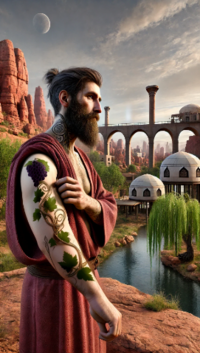
The most ancient and important of all Bassarid images, the grapevine represents abundance and fertility, and is seen as a manifestation of the blessings of the Supreme God of the Bassarid religion. Insofar as the grapevine undergoes cycles of growth, dormancy, and renewal, the vine serves as a symbol of transformation and rebirth. The emergence of the grapevine also represents the interconnection between man and nature, and of man's direct, personal relationship with Dionysus. The appearance of a new vine, and the growth of new grapes, are seen as positive omens, whereas the death of a grapevine is regarded as the worst of all possible omens.
The Serpent
Serpents ranging from snakes and lizards to fish, insects like centipedes and millipedes, and small mammals such as weasels, represent significant symbols of the complex, often contradictory nature of Dionysus and carry great significance within the religious context. Reptiles especially carry profound symbolic significance in the Bassarid religion. To this end, the shedding of a reptile's skin represents the rebirth and renewal which one experiences when following the religion's teachings. Such creatures, especially venomous snakes, also represent the intoxicating effects of Dionysus, and the god's mysterious, sacred chaos.
The Mermaid/Melusine
Stripping Path tradition holds that mermaids are the descendants of the first pirates who inhabited the Strait of Haifa, and that the queen of the mermaids, Melusine, was the most faithful servant of Ariadne, the bride of Dionysus. With that said, mermaids represent the feminine energies of creation, intuition, and receptivity which are central to Bassarid practices. They also represent the the exploration of the subconscious and the mysteries of the human soul. In the same way as mermaids inhabit and explore the deepest, darkest depths of the ocean, the Bassarid worshiper inhabits and explores the depths of their own individual spirit and existence.
The Sacred Hounds
The Reformed Stripping Path reveres two breeds of dogs above all others, regarding them as sacred companions of the Supreme God - the beagle and the great pyrenees. The beagle is the most faithful companion of Bacchus, and represents the tenacity which is required for for self-discovery, and the pursuit of authenticity. The Great Pyrenees is regarded as the protector of the Temples of Dionysus, and of the souls of his followers, and is regarded as a symbol of of devotion to the spiritual path.
The Juniper Tree
The fast-growing Juniper tree is regarded in the Reformed Stripping Path as a symbol of chaos. The rapid and often unpredictable expansion of juniper forests creates an environment that is constantly changing. This symbolizes the ever-shifting nature of life and the inability to pass through the same forest twice, emphasizing the impermanence of experiences, and the struggle of man to find order - direction - in the apparent chaos of nature.
Community Structure
Governance
Governance of the Reformed Stripping Path falls under the jurisdiction of the High Priestess of the Bassarid Temple of Vaeringheim, one of the three co-equal heads of state who comprise the Council of Kings, the supreme authority over Bassaridia Vaeringheim. The High Priestess is responsible for appointing Bassarid Priestesses to the Bacchanalia, the body of priestesses who are delegated the responsibility of overseeing the affairs of the religion's various Mysteries, or sects. The Bacchanalia, to this end, stands as a cornerstone of the religion's political framework, as it works on behalf of the High Priestess in order to ensure cohesion and to safeguard the sanctity of the spiritual practices embraced by the followers of the various Mysteries associated Reformed Stripping Path.
Conclusion
The Reformed Stripping Path draws significant influence from the other major Hostian belief systems, namely the Stripping Path for which the religion is named, the Pallisican Religion, and to a lesser extent the Alperkin religion. Of these, the Reformed Stripping Path is most heavily influenced by the former, although it is characterized by some key differences, especially with respect to its inclusion of indigenous religious traditions and its increased emphasis on the worship of Planetary Divines. The Reformed Stripping Path also deviates from the Stripping Path with respect to its views on the Triality of Oversouls. It is the case that whereas the Stripping Path promotes an embrace of chaos and a general rejection of order, the Reformed Stripping Path aligns its views with those of the Pallisican Religion, regarding the pursuit of order as the highest of spiritual aims. On the basis of this difference of views with respect to the Triality of Oversouls, the Reformed Stripping Path is regarded as being a significantly less extreme and subversive religion than the Stripping Path.


